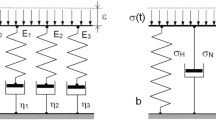Abstract
The effect of fat content in cheese curds on their rheological properties was examined using dynamic shear measurements. Surplus fat addition to milk samples caused two distinct types of changes in the temperature dependence of the viscoelastic moduli of resultant curds. The first was a significant reduction in the moduli over a wide temperature range, which is attributed to the presence of liquefied fat globules within the milk protein network. The second was the excess contribution to the low-temperature moduli owing to the reinforcing effect of solidified fat globules. An upward shift in the sol–gel phase transition temperature driven by an increased fat content was also observed.




Similar content being viewed by others
References
Michalski MC, Ollivon M, Briard V, Leconte N, Lopez C (2004) Native fat globules of different sizes selected from raw milk: thermal and structural behavior. Chem Phys Lipids 132:247–261
Walstra P, Wouters JTM, Geurts TJ (2006) Dairy science and technology, 2nd edn. CRC Press, Florida
Al-Nabulsi A, Shaker R, Osaili T, Clark S, Harte F, Barbosa-Cánovas G (2012) Impact of high hydrostatic pressure and heat treatments on milk gel properties: a comparative rheological study. Int J Food Prop 15:613–627
Catarino I, Martins APL, Duarte E, Prudêncio ES, de Pinho MN (2013) Rennet coagulation of sheep milk processed by ultrafiltration at low concentration factors. J Food Eng 114:249–254
Mistry VV (2001) Low fat cheese technology. Int Dairy J 11:413–422
Banks JM (2004) The technology of low-fat cheese manufacture. Int J Dairy Technol 57:199–207
Hennelly PJ, Dunne PG, O’Sullivan M, O’Riordan ED (2006) Textural, rheological and microstructural properties of imitation cheese containing inulin. J Food Eng 75:388–395
Childs JL, Drake M (2009) Consumer perception of fat reduction in cheese. J Sens Stud 24:902–921
Skeie S, Alseth G, Ostlie H, Abrahamsen R, Johansen A, Oyaas J (2013) Improvement of the quality of low-fat cheese using a two-step strategy. Int Dairy J 33:153–162
Johnston DE (1984) Application of polymer cross-linking theory to rennet-induced milk gels. J Dairy Res 51:91–101
Michalski MC, Camier B, Briard V, Leconte N, Gassi JY, Goudédranche H, Michel F, Fauquant J (2004) The size of native milk fat globules affects physico-chemical and functional properties of emmental cheese. Lait 84:343–358
Desai N, Nolting J (1994) Microstructure studies of reduced fat cheeses containing fat substitute. In: Malin EL, Tunick MH (eds) Chemistry of structure—function relationships in cheese. Plenum Press, New York
Jensen RG, Ferris AM, Lammi-Keefe CJ (1991) The composition of milk fat. J Dairy Sci 74:3228–3243
Lopez C (2005) Focus on the supramolecular structure of milk fat in dairy products. Reprod Nurtition Dev 45:497–511
Pilhofer GM, Lee HC, McCarthy MJ, Tong PS, German JB (1994) Functionality of milk fat in foam formation and stability. Lait 77:55–63
Gunasekaran S, Ak MM (2000) Dynamic oscillatory shear testing of foods-selected applications. Trends Food Sci Technol 11:115–127
Tunick MH (2011) Small-strain dynamic rheology of food protein networks. J Agric Food Chem 59:1481–1486
Noronha N, Duggan E, Ziegler GR, O’Riordan ED, O’Sullivan M (2008) Inclusion of starch in imitation cheese: its influence on water mobility and cheese functionality. Food Hydrocoll 22:1612–1621
Mounsey JS, O’Riordan ED (2008) Alteration of imitation cheese structure and melting behaviour with wheat starch. Eur Food Res Technol 226:1013–1019
van der Vaart K, Depypere F, Graef VD, Schall P, Fall A, Bonn D, Dewettinck K (2013) Dark chocolate’s compositional effects revealed by oscillatory rheology. Eur Food Res Technol 236:931–942
Zhang Y, Huang L, Wei Z (2014) Effects of additional fibrils on structural and rheological properties of rice bran albumin solution and gel. Eur Food Res Technol 239:971–978
Shima H, Tanimoto M (2015) Quantifying thermally induced flowability of rennet cheese curds. Int J Food Prop 18:2277–2283
Tung CYM, Dynes PJ (1982) Relationship between viscoelastic properties and gelation in thermosetting systems. J Appl Polym Sci 27:569–574
Ross-Murphy SB (1995) Rheological characterisation of gels. J Texture Stud 26:391–400
van Vileta T, Roefs SPFM, Walstra PZ (1989) Rheological properties of casein gels. J Dairy Res 56:529–534
Mleko S, Janas P, Pielecki J (2005) Study on stress relaxation behavior of rennet cheeses at different temperature. J Food Sci Technol 42:58–60
Ak M, Gunasekaran S (1996) Evaluating rheological properties of mozzarella cheese by the squeezing flow method. J Texture Stud 26:695–712
Acknowledgments
The authors express their gratitude to Emeritus Prof. Niki, R., Prof. Nishinari, K., Prof. Sato, K. and Mr. Ueda, K. for fruitful discussions and technical supports. This work was supported by JSPS KAKENHI Grant Numbers 25390147 and 25560035.
Author information
Authors and Affiliations
Corresponding author
Ethics declarations
Conflict of interest
None.
Compliance with ethics requirements
This article does not contain any studies with human or animal subjects.
Rights and permissions
About this article
Cite this article
Shima, H., Tanimoto, M. Effect of milk fat content on the viscoelasticity of mozzarella-type cheese curds. Eur Food Res Technol 242, 157–162 (2016). https://doi.org/10.1007/s00217-015-2525-8
Received:
Revised:
Accepted:
Published:
Issue Date:
DOI: https://doi.org/10.1007/s00217-015-2525-8



